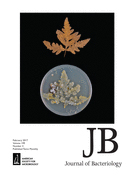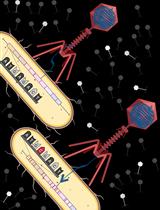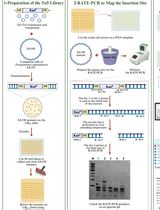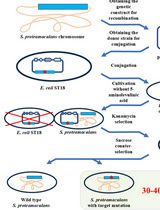- EN - English
- CN - 中文
Stationary-phase Mutagenesis Soft-agar Overlay Assays in Bacillus subtilis
枯草芽孢杆菌的软琼脂糖覆盖固相诱变
发布: 2017年12月05日第7卷第23期 DOI: 10.21769/BioProtoc.2634 浏览次数: 7025
评审: Valentine V TrotterAnonymous reviewer(s)
Abstract
Elucidating how a population of non-growing bacteria generates mutations improves our understanding of phenomena like antibiotic resistance, bacterial pathogenesis, genetic diversity and evolution. To evaluate mutations that occur in nutritionally stressed non-growing bacteria, we have employed the strain B. subtilis YB955, which measures the reversions rates to the chromosomal auxotrophies hisC952, metB5 and leuC427 (Sung and Yasbin, 2002). This gain-of-function system has successfully allowed establishing the role played by repair systems and transcriptional factors in stress-associated mutagenesis (SPM) (Barajas-Ornelas et al., 2014; Gómez-Marroquín et al., 2016). In a recent study (Castro-Cerritos et al., 2017), it was found that Ribonucleotide Reductase (RNR) was necessary for SPM; this enzyme is essential in this bacterium. We engineered a conditional mutant of strain B. subtilis YB955 in which expression of the nrdEF operon was modulated by isopropyl-β-D-thiogalactopyranoside (IPTG) (Castro-Cerritos et al., 2017). The conditions to determine mutation frequencies conferring amino acid prototrophy in three genes (hisC952, metB5, leuC427) under nutritional stress in this conditional mutant are detailed here. This technique could be used to evaluate the participation of essential genes in the mutagenic processes occurring in stressed B. subtilis cells.
Keywords: Bacillus subtilis (枯草芽孢杆菌)Background
Around 270 genes, including dnaA, dnaB, dnaC, involved in DNA replication as well as the nrdEF operon, which encodes RNR, are considered essential for B. subtilis growth (Kobayashi et al., 2003). Here we describe a protocol that has been applied to understand the role of this enzyme in modulating events of mutagenesis in nutritionally stressed non-growing cells of strain B. subtilis YB955 (hisC952, lecuC427, metB5). To this end, we implemented a genetic system that represses the expression of the essential nrdEF operon (non-permissive condition) while limiting two of the essential amino acids to avoid transient and weak phenotypes produced by variants of less efficient enzymes (Pybus et al., 2010). These restriction conditions allowed us first inquiring whether RNR influences mutagenesis in a population of non-growing (but viable) B. subtilis cells. In a second stage, a soft agar overlay, which provides permissive conditions for growth, allows detection of prototrophic colonies only if a mutation that restores at least one amino acid prototrophy has occurred. Whereas this protocol has been employed here with RNR, it can be potentially extended to study additional genes that are essential for metabolism as well as DNA replication and transcription. In addition, conditions may be adjusted to other bacterial species or selective markers.
Materials and Reagents
- 15- and 50-ml sterile Falcon tubes. Conical Centrifuge Tubes (Corning, Axygen®, catalog numbers: SCT-15ML-500 ; SCT-50ML-500 )
- Pasteur pipettes
- Disposable (90 mm diameter) Petri dishes (BD, catalog number: 252777 )
- Cellulose filter paper 0.22 µm (Merck, catalog number: GSWP04700 )
- Bacillus subtilis strains YB955 (hisC952 metB5 leuC427 xin-1 Spβs) and PERM1017 (hisC952 metB5 leuC427 ΔnrdE::lacZ Pspac-nrdEF::ery Eryr)
- Penassay broth (PAB; antibiotic medium 3; Difco Laboratories, Sparks, MD) (Fisher Scientific, catalog number: DF0243-17-8)
Manufacturer: BD, catalog number: B224320 . - Isopropyl-β-D-thiogalactoside (IPTG) (Promega, catalog number: V3951 )
- L-Leucine (Sigma-Aldrich, catalog number: L8000 )
- L-Glutamic acid (Sigma-Aldrich, catalog number: 49449 )
- L-Isoleucine (Sigma-Aldrich, catalog number: 58879 )
- L-Methionine (Sigma-Aldrich, catalog number: M9625 )
- L-Histidine monohydrochloride monohydrate (Sigma-Aldrich, catalog number: 53370 )
- Ammonium sulfate ((NH4)2SO4) (Karal, catalog number: 3016 )
- Potassium phosphate dibasic (K2HPO4) (Karal, catalog number: 5080 )
- Potassium phosphate monobasic (KH2PO4) (Karal, catalog number: 5079 )
- Sodium citrate (C6H5Na3O7·2H2O) (Avantor Performance Materials, J.T. Baker®, catalog number: 3646-01 )
- Magnesium sulfate heptahydrate (MgSO4·7H2O) (Karal, catalog number: 6056 )
- Magnesium chloride hexahydrate (MgCl2·6H2O) (Karal, catalog number: 6054 )
- Calcium chloride dihydrate (CaCl2·2H2O) (Sigma-Aldrich, catalog number: C2536 )
Note: This product has been discontinued. - Ferrous chloride tetrahydrate (FeCl2·4H2O) (Avantor Performance Materials, J.T. Baker®, catalog number: 2064-01 )
- Zinc chloride (ZnCl2) (Sigma-Aldrich, catalog number: Z0152 )
- Copper(II) chloride dihydrate (CuCl2·2H2O) (Karal, catalog number: 8021 )
- Cobalt(II) chloride hexahydrate (CoCl2·6H2O) (Karal, catalog number: 8026 )
- Sodium molybdate dehydrate (Na2MoO4·2H2O) (Karal, catalog number: 4072 )
- Agar (BD, catalog number: 215000 )
- Dextrose (BD, catalog number: 216800 )
- PAB medium (PAB) (see Recipes)
- Amino acid solutions (see Recipes)
- 1 M IPTG (see Recipes)
- 10x Spizizen salts (10x SS)
- 100x trace elements (see Recipes)
- Spizizen minimal salts (SS) (see Recipes)
- Spizizen minimal medium (SMM) (see Recipes)
- Soft agar (see Recipes)
Equipment
- Orbital shaker Lab-Line MaxQ 4000 (Thermo Fisher Scientific, Thermo ScientificTM, model: MaxQTM 4000 )
- Conventional incubator set at 37 °C
- Spectrophotometer (Biochrom, model: WPA CO7500 )
- Centrifuge Thermo Scientific IEC CL30R (Thermo Fisher Scientific, Thermo ScientificTM, model: IEC CL30R )
- Conventional autoclave
- 125-ml sterile Erlenmeyer flasks
- Reusable syringe filter holders (Merck, catalog number: SX0002500 )
- Magnetic stirring bar
Procedure
文章信息
版权信息
© 2017 The Authors; exclusive licensee Bio-protocol LLC.
如何引用
Castro-Cerritos, K. V., Villegas-Negrete, N., Ramirez-Ramirez, N., Robleto, E. A. and Pedraza-Reyes, M. (2017). Stationary-phase Mutagenesis Soft-agar Overlay Assays in Bacillus subtilis. Bio-protocol 7(23): e2634. DOI: 10.21769/BioProtoc.2634.
分类
微生物学 > 微生物遗传学 > 诱/突变
分子生物学 > DNA > 诱/突变
您对这篇实验方法有问题吗?
在此处发布您的问题,我们将邀请本文作者来回答。同时,我们会将您的问题发布到Bio-protocol Exchange,以便寻求社区成员的帮助。
提问指南
+ 问题描述
写下详细的问题描述,包括所有有助于他人回答您问题的信息(例如实验过程、条件和相关图像等)。
Share
Bluesky
X
Copy link


.jpg)

.jpg)










